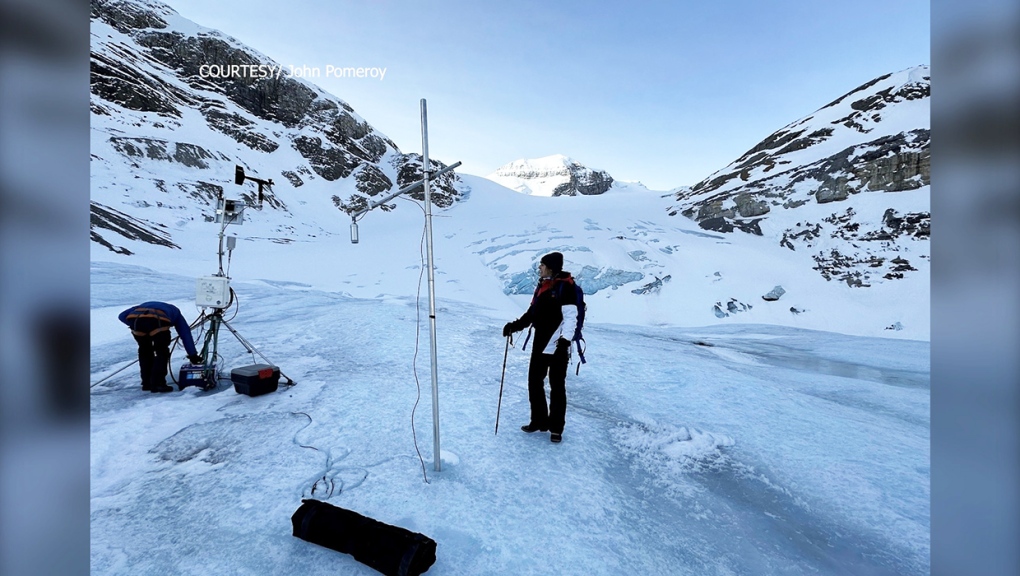‘Drop in the bucket’: Recent snowfall in southern Alberta not enough to prevent ongoing drought concerns
While the latest snowfall in Calgary is welcome amid growing concerns of drought, hydrologist experts say it’s only a ‘drop in the bucket’ of moisture that’s badly needed for the upcoming growing season.
“This is not going to be enough to generate a crop, or to get a good wheat crop. You need about 250 millimeters of moisture out of your soil, so we’re only one twentieth of the way there,” said John Pomeroy, director of Global Water Futures Observatories.
“Southern Alberta did get significant snowfall recently, but it’s only equivalent to a 10-to-15-millimeter rain. That’s welcome for sure, but not enough to fill the 100-millimeter deficit of soil moisture.”
Pomeroy says drought conditions in the prairies are also extending to the mountains where areas like the Peyto Glacier in Banff National Park are melting at a rate much faster than ever seen.
“The ice was bare and I’ve never seen that in March before, so it’s certainly an extraordinary situation,” he said.
“So, things get worse and worse for mountain snow and ice, that’s a big problem for water resources because those glaciers melt fastest in the hottest warm summers, like the drought we had last year. They helped a lot with streamflow in the North Saskatchewan River and in the Athabasca but as they shrink, we’ll lose that drought-proofing effect probably in just a few decades.”
NEW CLIMATE MODELS
Other local experts including Dr. Tricia Stadnyk are using new climate models to predict dry areas of the province that are getting drier.
The professor in the Schulich School of Engineering and Canada Research Chair in Hydrologic Modeling says Alberta is anywhere from 150 to 300 millimetres short of its needed snow water equivalent.
 Other local experts including Dr. Tricia Stadnyk are using new climate models to predict dry areas of the province that are getting drier. The professor in the Schulich School of Engineering and Canada Research Chair in Hydrologic Modeling says Alberta is anywhere from 150 to 300 millimetres short of its needed snow water equivalent.
Other local experts including Dr. Tricia Stadnyk are using new climate models to predict dry areas of the province that are getting drier. The professor in the Schulich School of Engineering and Canada Research Chair in Hydrologic Modeling says Alberta is anywhere from 150 to 300 millimetres short of its needed snow water equivalent.
MAKE OR BREAK FOR FARMERS
She notes that drought conditions could be make or break for farmers this growing season.
“The thing that people need to understand is it’s not just the amount of precipitation that falls in terms of snow or rain, but it’s also what happens after that, how hot the temperatures get and how fast it warms up,” Stadnyk said.
“Because if all of a sudden all of this melts at once, it actually does less good for the farmers and for the environment than it does if it melts over an extended period of time because the water is more apt to stay in the soil rather than to run off of the soil.”
Local farmers like John Smith, who owns the Plateau Cattle Company just south of Calgary near Nanton are already feeling the effects of drought.
“Last year, this ranch usually as a rule would make 2,000 hay bales and last year we made only 100 bales,” he said.
“So you know, I can’t stress enough how much of an impact that is on the operation here.”
Smith says he’s had to significantly make changes, including downsizing his operation from 600 cows to now 400. He also says many ranchers are getting creative by taking cows to nearby feedlots that produce more hay, or sourcing hay out of Montana.
“We’re really going to find out here in the next two, three months, like March, April, May, June, you know, those are our highest water occurrences for the year.”
“If something doesn’t happen here immediately and significantly it won’t be good, I mean it could rain a foot in the summer, and I think we’d still be at a deficit.”
The growing concerns over both drought and floods have now led the province to announce a multi-million dollar program to help municipalities cope.
A total of $125 million will be spread evenly over the next five years for infrastructure projects that help municipalities handle drought and flood.
The new funding can be used for projects like berms, water storage or other infrastructure work. It comes as the province rolls out a swath of plans and programs to address expected water shortages.
View original article here Source









